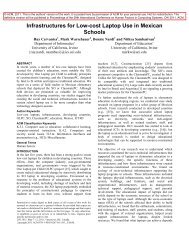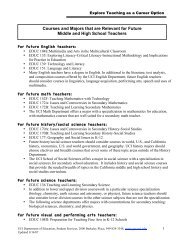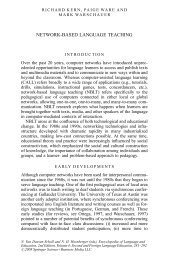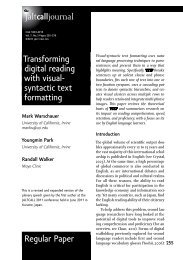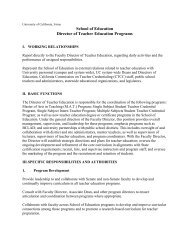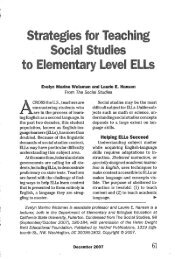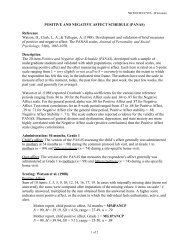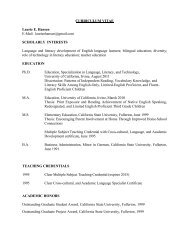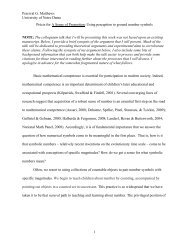Online Learning in Sociocultural Context - Department of Education
Online Learning in Sociocultural Context - Department of Education
Online Learning in Sociocultural Context - Department of Education
You also want an ePaper? Increase the reach of your titles
YUMPU automatically turns print PDFs into web optimized ePapers that Google loves.
<strong>Onl<strong>in</strong>e</strong> <strong>Learn<strong>in</strong>g</strong> <strong>in</strong> <strong>Sociocultural</strong> <strong>Context</strong><br />
MARKWARSCHAUER<br />
University <strong>of</strong> Hawai'i at Manoa<br />
Proponents <strong>of</strong> onl<strong>in</strong>e learn<strong>in</strong>g claim that it can transform education by promot<strong>in</strong>g<br />
student-centered communication, collaboration, and <strong>in</strong>quiry. Yet these<br />
claims must be weighed aga<strong>in</strong>st the actual implementation <strong>of</strong> onl<strong>in</strong>e learn<strong>in</strong>g,<br />
which is <strong>in</strong>fluenced by a broad range <strong>of</strong> sociocultural factors. This study<br />
<strong>in</strong>vestigates sociocultural factors that helped shape a computer-based English as<br />
a Second Language (ESL) writ<strong>in</strong>g course <strong>in</strong> a conservative Christian college,<br />
factors that <strong>in</strong>cluded a complex relationship between teacher, researcher, and<br />
students.<br />
For the last 20 years, the educational literature has been replete with<br />
articles about the promis<strong>in</strong>g potential <strong>of</strong> new applications <strong>of</strong> microcomputers<br />
<strong>in</strong> the classroom, only to be followed a year or two later with<br />
disappo<strong>in</strong>t<strong>in</strong>g reports <strong>of</strong> the actual implementation. As Cuban has ably<br />
documented (1986, 1993), the actual use <strong>of</strong> new technologies <strong>in</strong> the<br />
classroom is sharply constra<strong>in</strong>ed by broad sociocultural variables such<br />
as the role <strong>of</strong> schools as an <strong>in</strong>strument <strong>of</strong> social control and sort<strong>in</strong>g, the<br />
general culture <strong>of</strong> teach<strong>in</strong>g, and the beliefs <strong>of</strong> classroom teachers. As a<br />
result, new media are usually <strong>in</strong>troduced <strong>in</strong> a top-down fashion at odds<br />
with sound educational pr<strong>in</strong>ciples, and microcomputers are frequently<br />
used for drill-and-practice activities requir<strong>in</strong>g low-level cognitive skills<br />
<strong>of</strong> rote memory and application (Cumm<strong>in</strong>s and Sayers 1990).' And, as<br />
studies have shown (see, for example, Mehan et al. 1985; Roberts 1987),<br />
it is ethnic and language m<strong>in</strong>ority students who are least likely to have<br />
access to computers or to use them for challeng<strong>in</strong>g, problem-solv<strong>in</strong>g<br />
activities.<br />
Now, with the rapid growth <strong>of</strong> the Internet, one wonders if the cycle<br />
<strong>of</strong> praise and disappo<strong>in</strong>tment is beg<strong>in</strong>n<strong>in</strong>g aga<strong>in</strong>. <strong>Onl<strong>in</strong>e</strong> learn<strong>in</strong>g has<br />
quickly become the most-touted current application <strong>of</strong> computers <strong>in</strong><br />
education (see, for example, Berge and Coll<strong>in</strong>s 1995; Cumm<strong>in</strong>s and<br />
Sayers 1995; Harasim 1990b; Harasim et al. 1995). Accord<strong>in</strong>g to its<br />
supporters, onl<strong>in</strong>e education "<strong>in</strong>troduces unprecedented options for<br />
teachng, learn<strong>in</strong>g and knowledge build<strong>in</strong>g" (Harasim 1990a:xvii) and<br />
can help "create communities <strong>of</strong> <strong>in</strong>quiry capable <strong>of</strong> stimulat<strong>in</strong>g <strong>in</strong>tellectual,<br />
moral, and educational growth among rich and poor alike" (Cumm<strong>in</strong>s<br />
and Sayers 1995:ix).<br />
Yet these positive assessments <strong>of</strong> the potential <strong>of</strong> onl<strong>in</strong>e education<br />
have not yet been sufficiently backed up by systematic studies <strong>of</strong> the<br />
Anthropology 6 <strong>Education</strong> Quarterly 29(1):68-88. Copyright O 1998, American<br />
Anthropological Association.<br />
68
Warschauer<br />
<strong>Onl<strong>in</strong>e</strong> <strong>Learn<strong>in</strong>g</strong><br />
69<br />
actual uses <strong>of</strong> onl<strong>in</strong>e learn<strong>in</strong>g <strong>in</strong> the schools. With<strong>in</strong> my own area,<br />
second-language learn<strong>in</strong>g, published studies <strong>of</strong> onl<strong>in</strong>e education have<br />
mostly consisted <strong>of</strong> <strong>in</strong>novative teachers report<strong>in</strong>g anecdotally on their<br />
own successful practices (see, for example, Barson et al. 1993; Kern 1995b;<br />
Soh and Soon 1991; Warschauer 1995). More methodical research (see,<br />
for example, Chun 1994; Kern 1995a; Warschauer 1996) has tended to<br />
exam<strong>in</strong>e one or two particular aspects (for example, the discourse <strong>in</strong> an<br />
onl<strong>in</strong>e session) rather than provide a grounded, longitud<strong>in</strong>al, and contextualized<br />
account <strong>of</strong> the overall implementation <strong>of</strong> the onl<strong>in</strong>e activities<br />
and <strong>of</strong> the students' experiences. And the very few contextualized<br />
ethnographic studies that have been published <strong>in</strong> this area (for an<br />
excellent study see Tella 1991) have exam<strong>in</strong>ed the experiences <strong>of</strong> "ma<strong>in</strong>stream"<br />
middle-class students rather than ethnic or language m<strong>in</strong>orities.<br />
To help fill this gap, I conducted a semester-long ethnographic study<br />
<strong>of</strong> an ESL composition class at Miller College? a medium-sized Christian<br />
<strong>in</strong>stitution <strong>of</strong> higher learn<strong>in</strong>g <strong>in</strong> Hawai'i. I chose this particular class for<br />
the study because (1)it was largely taught through onl<strong>in</strong>e activities; (2)<br />
the students were a culturally diverse group from a broad range <strong>of</strong><br />
Pacific, Asian, and South American countries; and (3) the teacher <strong>of</strong> the<br />
course, Ms. Sanderson, was enthusiastic about <strong>in</strong>vit<strong>in</strong>g me <strong>in</strong> as a researcher<br />
and collaborator. That Miller College was a conservative Christian<br />
<strong>in</strong>stitution was not a factor <strong>in</strong> my selection <strong>of</strong> the class, although I<br />
realized that that was part <strong>of</strong> the sociocultural context that could affect<br />
the way classroom <strong>in</strong>struction was carried out.<br />
In conduct<strong>in</strong>g the study, I was not a neutral observer. First <strong>of</strong> all, I had<br />
my own well-developed beliefs about the potential <strong>of</strong> onl<strong>in</strong>e learn<strong>in</strong>g,<br />
based on a sociocultural perspective that emphasizes the importance <strong>of</strong><br />
creat<strong>in</strong>g communities <strong>of</strong> practice and semiotic apprenticeship <strong>in</strong> the<br />
classroom (Bayer 1990; Wells and Chang-Wells 1992). I felt that computer-mediated<br />
communication, by giv<strong>in</strong>g students opportunities for<br />
cooperative writ<strong>in</strong>g with each other and with distant partners, provided<br />
an excellent tool for promot<strong>in</strong>g critical, collaborative learn<strong>in</strong>g. Beyond<br />
this belief, I was biased <strong>in</strong> an additional sense. The teacher <strong>of</strong> the course<br />
(Ms. Sanderson) and I agreed that I would actively work with her <strong>in</strong><br />
shar<strong>in</strong>g my thoughts and ideas about the learn<strong>in</strong>g objectives and activities<br />
throughout the plann<strong>in</strong>g and implementation <strong>of</strong> the course. Rather<br />
than be<strong>in</strong>g an outside researcher, I would thus be a partner <strong>in</strong> collaborative<br />
education and <strong>in</strong>quiry. Though <strong>in</strong> the end this process <strong>of</strong> collaboration<br />
did not develop <strong>in</strong> quite the ways we had imag<strong>in</strong>ed, it nevertheless<br />
proved to be animportant factor that had some <strong>in</strong>fluence on the outcome<br />
<strong>of</strong> the course.<br />
A Walk through Miller College<br />
A first-time visitor to Miller College-with its well-manicured lawns,<br />
quiet and clean grounds, and polite, conservatively dressed students-gets<br />
the sensation <strong>of</strong> enter<strong>in</strong>g a small town <strong>in</strong> the 1950s. A walk
70 Anthropology 6 <strong>Education</strong> Quarterly Volume 29,1998<br />
through the campus dispels any l<strong>in</strong>ger<strong>in</strong>g doubts that this is a conservative<br />
<strong>in</strong>stitution. The college's dress code is posted prom<strong>in</strong>ently on all<br />
build<strong>in</strong>gs. (For example, "Sideburns should not be long or busy, and<br />
should not extend below the bottom <strong>of</strong> the ear.") Signs posted <strong>in</strong> the<br />
cafeteria urge students to "Stop legalized abortion" and to say "No to<br />
legalized gambl<strong>in</strong>g." A front-page headl<strong>in</strong>e on the school newspaper<br />
asks, "Judgment Day: Will you want justice or mercy?"<br />
A visit to the campus bookstore confirms the conservative orientation<br />
<strong>of</strong> the campus. A recent book, prom<strong>in</strong>ently displayed near the entrance,<br />
conta<strong>in</strong>s chapters such as "One True Church and "Teach<strong>in</strong>g Pure<br />
Doctr<strong>in</strong>e." The book expla<strong>in</strong>s that doctr<strong>in</strong>e cannot be learned through<br />
experience or active <strong>in</strong>terpretation, but must be taught from above.<br />
Another recent book (also on prom<strong>in</strong>ent display) emphasizes the importance<br />
<strong>of</strong> teach<strong>in</strong>g the pr<strong>in</strong>ciples <strong>of</strong> the gospel rather than teach<strong>in</strong>g ethics.<br />
Other books discuss the church's active role <strong>in</strong> work<strong>in</strong>g to br<strong>in</strong>g ths<br />
doctr<strong>in</strong>e and its pr<strong>in</strong>ciples to the peoples <strong>of</strong> develop<strong>in</strong>g nations.<br />
Accord<strong>in</strong>g to the college catalogue, the church's <strong>in</strong>stitutes <strong>of</strong> higher<br />
learn<strong>in</strong>g, <strong>in</strong>clud<strong>in</strong>g Miller College, were established for the purpose <strong>of</strong><br />
assist<strong>in</strong>g these goals, both by tra<strong>in</strong><strong>in</strong>g students <strong>in</strong> church doctr<strong>in</strong>e and<br />
prepar<strong>in</strong>g them to serve the church. The catalogue states that "All<br />
students at Miller College should be taught the truths <strong>of</strong> the gospel <strong>of</strong><br />
Jesus Christ." The church president is quoted as say<strong>in</strong>g that "those who<br />
are blessed to attend [Miller College] have a great responsibility to make<br />
certa<strong>in</strong> that the Church's <strong>in</strong>vestment <strong>in</strong> them provides dividends<br />
through service and dedication to others as they labor <strong>in</strong> the Church and<br />
<strong>in</strong> the world."<br />
Miller College thus plays a prom<strong>in</strong>ent role <strong>in</strong> the church's missionary<br />
work, especially <strong>in</strong> the Asia-Pacific region. American students who<br />
attend Miller are generally <strong>in</strong>volved <strong>in</strong> missionary work <strong>in</strong> Asia and the<br />
Pacific. The majority <strong>of</strong> Miller's students, however, are not Americans,<br />
but are rather foreign students from the Pacific. Most have been <strong>in</strong>volved<br />
<strong>in</strong> church activities <strong>in</strong> their countries and are learn<strong>in</strong>g the church's<br />
pr<strong>in</strong>ciples and develop<strong>in</strong>g leadership skills so that they will return to<br />
their countries as more capable church representatives.<br />
Ms. Sanderson's Class<br />
Ms. Sanderson's class is composed entirely <strong>of</strong> <strong>in</strong>ternational students.<br />
Ten are Pacific Islanders from Tonga, Pohnpei, Palau, Samoa, Tahiti, and<br />
the Cook Islands, with the rema<strong>in</strong><strong>in</strong>g six from Japan, Indonesia, Mongolia,<br />
Korea, and Brazil. The course is an advanced ESL composition class<br />
<strong>in</strong> the college's English Language Program. Students <strong>in</strong> this program<br />
have been admitted to the university, but due to low test scores are<br />
required to complete some special ESL classes. The purpose <strong>of</strong> ths<br />
particular class is that students sufficiently master the genres <strong>of</strong> U.S.<br />
academic writ<strong>in</strong>g so that they will be able to succeed <strong>in</strong> regular college<br />
classes.
Warschauer<br />
<strong>Onl<strong>in</strong>e</strong> <strong>Learn<strong>in</strong>g</strong><br />
71<br />
Ms. Sanderson's class meets four times a week, twice <strong>in</strong> a computer<br />
lab and twice <strong>in</strong> a regular classroom. I visited the class once every one to<br />
two weeks throughout the semester, and between classes I stayed <strong>in</strong><br />
touch with Ms. Sanderson and the students via e-mail. I received copies<br />
<strong>of</strong> nearly all the e-mail messages and texts the students wrote throughout<br />
the semester. I <strong>in</strong>terviewed students <strong>in</strong> four rounds throughout the<br />
semester on a voluntary basis, with 12 out <strong>of</strong> the 16 students participat<strong>in</strong>g<br />
<strong>in</strong> one or more <strong>of</strong> the <strong>in</strong>terviews. I also talked <strong>in</strong>formally with<br />
students before or after class, <strong>in</strong> the computer lab, and <strong>in</strong> the cafeteria.<br />
In the end, the course developed <strong>in</strong> ways that I had not expected, but<br />
the experience <strong>of</strong> discover<strong>in</strong>g and work<strong>in</strong>g through this proved to be a<br />
valuable one for the teacher, students, and me. The process revealed a<br />
great deal about the sociocultural context <strong>of</strong> collaborative comput<strong>in</strong>g, as<br />
shaped by both <strong>in</strong>stitutional goals and values and also by ongo<strong>in</strong>g<br />
negotiation between teacher and researcher. The follow<strong>in</strong>g, then, describes<br />
my experience <strong>in</strong> Ms. Sanderson's class.<br />
Discipl<strong>in</strong>e and Order <strong>in</strong> the Classroom<br />
The atmosphere <strong>of</strong> discipl<strong>in</strong>e and obedience that pervades the college<br />
is apparent <strong>in</strong> Ms. Sanderson's class as well. The students work quietly<br />
and <strong>in</strong> an orderly fashion, without gett<strong>in</strong>g out <strong>of</strong> their seats to work with<br />
classmates at other computers. They raise their hands politely when they<br />
want to ask a question or need assistance. A wall display <strong>in</strong> the computer<br />
lab conta<strong>in</strong>s gold stars for students who have successfully completed<br />
their assignments.<br />
Every class <strong>in</strong> the computer lab beg<strong>in</strong>s with a five-m<strong>in</strong>ute assignment<br />
or quiz, which is sent to the students over e-mail (for example, "Correct<br />
the follow<strong>in</strong>g sentence: It was not until the 1970s that the International<br />
Cultural Center become one <strong>of</strong> most popular visit<strong>in</strong>g sites."). Students<br />
must complete the quiz and send it back withn the allotted five m<strong>in</strong>utes<br />
or they receive no credit. After the five m<strong>in</strong>utes are up, Ms. Sanderson<br />
announces that no more credit will be given for the quiz. She expla<strong>in</strong>s<br />
that "the class meets really early <strong>in</strong> the morn<strong>in</strong>g, and I'm worried about<br />
them com<strong>in</strong>g late. This helps make sure they get here on time."<br />
These quizzes were <strong>of</strong> great frustration to many <strong>of</strong> the students,<br />
especially the ones who were new to computers and could not work very<br />
fast. Don, from Tonga, had never worked with computers before and<br />
was always a little bit beh<strong>in</strong>d <strong>in</strong> class. While other students were complet<strong>in</strong>g<br />
their quizzes, he was <strong>of</strong>ten still try<strong>in</strong>g to figure out how to log <strong>in</strong>.<br />
Inevitably, when the five m<strong>in</strong>utes were up, he still could not complete<br />
the assignment, no matter how hard he tried. I never saw Don smile <strong>in</strong><br />
class.<br />
The standards <strong>of</strong> discipl<strong>in</strong>e and hard work are applied to the quantity<br />
<strong>of</strong> assignments as well. A handout students receive the first day (which<br />
warns them twice to respect the dress code) expla<strong>in</strong>s <strong>in</strong> great detail an<br />
exhaustive list <strong>of</strong> assignments to be completed dur<strong>in</strong>g the semester,
72 Anthropology G. <strong>Education</strong> Quarterly Volume 29, 1998<br />
<strong>in</strong>clud<strong>in</strong>g 60 grammatical exercises, five typ<strong>in</strong>g tests, 10 take-home<br />
essays, five<strong>in</strong>-class essays, two read<strong>in</strong>g reports, 20 "key pal" (e-mailpen<br />
pal) letters, and a f<strong>in</strong>al research paper. Ms. Sanderson works extremely<br />
hard correct<strong>in</strong>gall <strong>of</strong> these assignments, on occasion stay<strong>in</strong>g at her <strong>of</strong>fice<br />
all night <strong>in</strong> order to keep up with her work.<br />
Ms. Sanderson's concernwith rules and order also extends to her view<br />
<strong>of</strong> composition. She is not a proponent <strong>of</strong> freewrit<strong>in</strong>g or discovery<br />
writ<strong>in</strong>g.Rather,her verbal <strong>in</strong>structions and handouts expla<strong>in</strong> to students<br />
exactly what is expected <strong>in</strong> a composition, as can be seen <strong>in</strong> this handout:<br />
Remember that <strong>in</strong> comparison writ<strong>in</strong>g, you are present<strong>in</strong>g similarities<br />
(not differences!).<br />
Your organization is important:<br />
an <strong>in</strong>troduction <strong>of</strong> three sentences with a thesis statement at the end,<br />
development paragraphs (2-3)with<br />
keyword and "most important" transitions <strong>in</strong> each paragraph<br />
comparison transition <strong>in</strong> the body <strong>of</strong> each paragraph<br />
a conclusion <strong>of</strong> at least three sentences.<br />
Your ideas should be thoroughly developed (5+ sentences per paragraph)<br />
for high "content."<br />
The focus on correct form and organization corresponds with what<br />
the students seem to expect <strong>of</strong> the class. When asked what good writ<strong>in</strong>g<br />
entails, or what they need to improve their writ<strong>in</strong>g, most students<br />
mentioned features related to organization or mechanics. One student,<br />
when asked what he liked most about the class, said, "I like how she<br />
gives us the structures <strong>of</strong> essays. For example, putt<strong>in</strong>g a comma before<br />
the word and <strong>in</strong> a series. I was taught not to put the comma <strong>in</strong> my<br />
country."<br />
Peer edit<strong>in</strong>g is conducted, but without any opportunity to discuss the<br />
ideas <strong>in</strong> papers. Rather, students are given five m<strong>in</strong>utes to both read a<br />
paper and assign it up to 20 po<strong>in</strong>ts each <strong>in</strong> five categories (content,<br />
vocabulary,organization, language use, and mechanics).From observations<br />
and the students' comments, it is clear that these peer evaluations<br />
are conducted without much thought.<br />
Uses <strong>of</strong> Technology<br />
Dur<strong>in</strong>g the first week <strong>of</strong> class, a quiet Polynesian student made the<br />
excit<strong>in</strong>g realization that she could use the computer system not only to<br />
write to her classmatesbut also to her faraway friends.Shequicklyjotted<br />
out a note to a friend at another university, us<strong>in</strong>g colloquial language,<br />
and asked how to fill <strong>in</strong> the e-mail address and send it. Ms. Sanderson<br />
glanced at her letter and sternly told her to check her grammar first.The<br />
class ended without the student learn<strong>in</strong>g how to address the message,<br />
and it went unsent.<br />
A similar example occurred later on when the students first learned<br />
how to use the World Wide Web. Clearly, one <strong>of</strong> the most excit<strong>in</strong>g
Warschauer<br />
<strong>Onl<strong>in</strong>e</strong> <strong>Learn<strong>in</strong>g</strong><br />
73<br />
features <strong>of</strong> the Internet is how the World Wide Web can be used to<br />
quickly gather <strong>in</strong>formation from a great variety <strong>of</strong> sources from all over<br />
the world. Ms. Sanderson's students did not discover this fact on that<br />
day, nor, to my knowledge, until the very end <strong>of</strong> the semester. Rather,<br />
they were <strong>in</strong>structed exactly how to navigate through the college's Web<br />
pages to an onl<strong>in</strong>e grammatical exercise that they then completed.<br />
These two examples illustrate how electronic technology was used as<br />
a tool to implement and re<strong>in</strong>force the rule-based functions <strong>of</strong> the class.<br />
Students spent about four hours a week complet<strong>in</strong>g computer-based<br />
grammar exercises. They also spent additional hours complet<strong>in</strong>g Typ<strong>in</strong>g<br />
Tutor exercises, which were mandatory even for those students who<br />
knew how to type. Most important, however, was the fact that almost<br />
all electronic communication, whether between the students and<br />
teacher, among the students <strong>in</strong> the class, or with long-distance pen pals<br />
was directed toward correct form rather than express<strong>in</strong>g mean<strong>in</strong>g.<br />
For example, the students worked <strong>in</strong> small electronic groups throughout<br />
the semester, e-mail<strong>in</strong>g paragraphs back and forth which their<br />
classmates corrected for grammar and spell<strong>in</strong>g and then e-mailed back.<br />
The students also decided <strong>in</strong> advance their topic sentences for each<br />
paragraph, and e-mailed these to their classmates for correction and<br />
feedback. The students wrote weekly essays that they e-mailed to the<br />
teacher for correction and comment. The students then sent the corrected<br />
essays, with a sentence or two <strong>of</strong> <strong>in</strong>troduction, as letters (<strong>of</strong> a sort) to their<br />
long-distance key pals. Each letter was retyped (or, for the more computer-literate<br />
students, cut and pasted) <strong>in</strong> four different messages with<br />
a slightly different <strong>in</strong>troduction to four different key pals, and then given<br />
a grade. A bold pr<strong>in</strong>t warn<strong>in</strong>g on the first handout notified students that<br />
"The <strong>in</strong>structor will not give credit for e-mailed key pal letters which<br />
have not been submitted <strong>in</strong> draft form for prior response on the due date"<br />
(emphasis <strong>in</strong> orig<strong>in</strong>al).<br />
Although students were generally <strong>in</strong>terested <strong>in</strong> improv<strong>in</strong>g their grammar<br />
and form, they still chafed at the tremendous amount <strong>of</strong> time they<br />
spent at computer tasks they saw as weakly related to develop<strong>in</strong>g their<br />
writ<strong>in</strong>g skills. As Kat<strong>in</strong>a, a Samoan student, said,<br />
The whole th<strong>in</strong>g is a big overload. There's a typ<strong>in</strong>g 101class, so all this typ<strong>in</strong>g<br />
is a big overload. For some <strong>of</strong> us who know how to type, it's a big waste <strong>of</strong><br />
time. But if ifs help<strong>in</strong>g us with our grade <strong>in</strong> the class, we do it. But why should<br />
we spend our time on this <strong>in</strong>stead <strong>of</strong> on someth<strong>in</strong>g useful?<br />
Many students found the post<strong>in</strong>g <strong>of</strong> essays to key pals particularly<br />
frustrat<strong>in</strong>g. As M<strong>in</strong>da, a Tongan student, commented, "I'm just try<strong>in</strong>g<br />
to write the same th<strong>in</strong>g to eight people, to write the same thng <strong>in</strong> a little<br />
bit different ways. It's a waste <strong>of</strong> time."
74 Anthropology 6 <strong>Education</strong> Quarterly Volume 29, 1998<br />
Topics and Content<br />
Follow<strong>in</strong>g a suggestion I had orig<strong>in</strong>ally made, the writ<strong>in</strong>g assignments<br />
for the semester were all built around the theme <strong>of</strong> "culture." This did<br />
not lead, however, to the k<strong>in</strong>d <strong>of</strong> critical sociocultural analysis I had<br />
<strong>in</strong>tended. Rather, the view <strong>of</strong> culture that pervaded the class was <strong>in</strong><br />
perfect accord with the state's International Culture Center, where tourists<br />
from around the world sampled foods, music, and dance <strong>in</strong> a variety<br />
<strong>of</strong> Pacific Island villages. As Ms. Sanderson wrote on the board one day,<br />
<strong>in</strong> her class culture consisted <strong>of</strong><br />
1. climate<br />
2. food/cloth<strong>in</strong>g<br />
3. music/dance/enterta<strong>in</strong>ment<br />
4. school/education<br />
5. family/values<br />
Students' essays thus tended to focus on describ<strong>in</strong>g tourist sites <strong>in</strong> the<br />
United States and their country, compar<strong>in</strong>g food, music, and enterta<strong>in</strong>ment,<br />
and describ<strong>in</strong>g why they chose to come to this college. The essays<br />
were <strong>in</strong>evitably <strong>in</strong> a standard five-paragraph form, with the first paragraph<br />
<strong>in</strong>troduc<strong>in</strong>g the three po<strong>in</strong>ts (i.e., three ma<strong>in</strong> reasons why I want<br />
to get an education are . . . ), the next three paragraphs expla<strong>in</strong><strong>in</strong>g each<br />
po<strong>in</strong>t, and the last paragraph repeat<strong>in</strong>g the po<strong>in</strong>ts. The essays were <strong>of</strong>ten<br />
coherent and cohesive, but to an outsider's eye lacked creativity or<br />
orig<strong>in</strong>ality.<br />
Students' Impressions<br />
At the beg<strong>in</strong>n<strong>in</strong>g <strong>of</strong> the class, students were generally excited about<br />
the opportunity to work with computers, whch they saw as important<br />
to their academic success and careers. As one student told me, "Us<strong>in</strong>g<br />
computers, learn<strong>in</strong>g different thngs, e-mail, everyth<strong>in</strong>g, I hated it before,<br />
but there's a say<strong>in</strong>g, 'Conquer or you'll be conquered.' So I wanna<br />
conquer [rather] than be conquered, so I have to learn. I love it. I th<strong>in</strong>k<br />
it's so important for me."<br />
As the semester went on, though, nearly all the students became<br />
frustrated at the tremendous number <strong>of</strong> assignments, many <strong>of</strong> which<br />
seemed peripheral to learn<strong>in</strong>g how to write. As Kat<strong>in</strong>a told me,<br />
I th<strong>in</strong>k this class is called writ<strong>in</strong>g. Essay writ<strong>in</strong>g is what we should be do<strong>in</strong>g,<br />
someth<strong>in</strong>g that would help us learn how to write. Computer grammar exercises<br />
are a waste <strong>of</strong> time. The style <strong>of</strong> writ<strong>in</strong>g to key pals, just redo<strong>in</strong>g the essays<br />
and send<strong>in</strong>g them to the key pals, iPs a waste <strong>of</strong> time. She doesn't see what's<br />
go<strong>in</strong>g on. On my essay, I always get 19 out <strong>of</strong> 20. But I fell beh<strong>in</strong>d because I<br />
couldn't do all those other assignments.<br />
It was at the time <strong>of</strong> my second round <strong>of</strong> <strong>in</strong>terviews, right <strong>in</strong> the middle<br />
<strong>of</strong> the semester, that student dissatisfaction seemed to be strongest.
Warschauer<br />
<strong>Onl<strong>in</strong>e</strong> <strong>Learn<strong>in</strong>g</strong><br />
75<br />
Though the students were not accustomed to compla<strong>in</strong><strong>in</strong>g to the teacher,<br />
nor the teacher accustomed to solicit<strong>in</strong>g their views, the very fact <strong>of</strong><br />
conduct<strong>in</strong>g the <strong>in</strong>terviews seemed to prove a catalyst for change. On the<br />
one hand, the students, merely by hav<strong>in</strong>g the opportunity to voice their<br />
op<strong>in</strong>ions to a sympathetic outsider, seemed to ga<strong>in</strong> confidence <strong>in</strong> their<br />
op<strong>in</strong>ions. On the other hand, the teacher, consciously or unconsciously<br />
aware that the students were unhappy, now had to contend with the<br />
realization that their unhapp<strong>in</strong>ess was somehow com<strong>in</strong>g out for <strong>in</strong>spection.<br />
Thus, immediately after the second round <strong>of</strong> <strong>in</strong>terviews (which were<br />
conducted privately between me and the students), Ms. Sanderson sent<br />
me an e-mail urg<strong>in</strong>g me to "help us strengthen the positive and improve,<br />
as well as help me cont<strong>in</strong>ue to build the class rapport I've been work<strong>in</strong>g<br />
at the last couple <strong>of</strong> weeks." Two days later, follow<strong>in</strong>g the next meet<strong>in</strong>g<br />
<strong>of</strong> the class, she wrote to me that<br />
The class seemed a bit glum when we started and wouldn't look me <strong>in</strong> the eye<br />
this morn<strong>in</strong>g. . . . A couple <strong>of</strong> them admitted they were discouraged with the<br />
key pal bit, so I told them this week's key pal assignment is the last one with<br />
an assigned topic . . . after that it's free correspondence as long as they get the<br />
<strong>in</strong>formation they need for a good comparison-contrast research paper and<br />
have at least 20 exchanges total among the two to four key pals. They seemed<br />
satisfied with that.<br />
The change, which meant that students could now write what they<br />
wished to key pals <strong>in</strong>stead <strong>of</strong> submitt<strong>in</strong>g letters to her for grades, greatly<br />
satisfied the students. Other improvements were implemented <strong>in</strong> the<br />
follow<strong>in</strong>g weeks, <strong>in</strong>clud<strong>in</strong>g allow<strong>in</strong>g the students a good deal <strong>of</strong> autonomy<br />
<strong>in</strong> shoot<strong>in</strong>g and edit<strong>in</strong>g their own video to be sent to the partner<br />
class. (The topics <strong>of</strong> the video---climate, food, music, education, and<br />
family and values-were still determ<strong>in</strong>ed by the teacher.) The teacher<br />
posted the students' essays on the World Wide Web, which brought<br />
them a lot <strong>of</strong> pride. And the students were f<strong>in</strong>ally taught how to navigate<br />
the Web to f<strong>in</strong>d articles related to their own <strong>in</strong>terest, which they also<br />
enjoyed very much.<br />
By the end <strong>of</strong> the semester, a number <strong>of</strong> students expressed general<br />
satisfaction with the class. Others, though not<strong>in</strong>g some improvement,<br />
still had strong criticisms. The variety <strong>of</strong> student experiences is captured<br />
by look<strong>in</strong>g at two students, Jon and Paolo.<br />
Jon<br />
Jon,21 years old, was born <strong>in</strong> a small village <strong>of</strong> the Cook Islands. He<br />
has been a member <strong>of</strong> the church all his life and saw com<strong>in</strong>g to this<br />
college as a natural but wonderful opportunity. He worked <strong>in</strong> construction<br />
for three years after high school <strong>in</strong> order to save enough money for<br />
him and his wife to come study at Miller College.<br />
Neither Jon nor h s wife, L<strong>in</strong>da (who was also <strong>in</strong> the class), had any<br />
experience with computers, and both seemed disoriented the first weeks
76 Anthropology & <strong>Education</strong> Quarterly Volume 29, 1998<br />
<strong>of</strong> class. Yet both worked extremely hard and received excellent marks.<br />
Jon beamed with pride as he talked <strong>of</strong> his accomplishments:<br />
We learned a lot <strong>of</strong> tricks on the computer with Ms. Sanderson, how to do<br />
e-mail and th<strong>in</strong>gs. The other day, I was <strong>in</strong> the computer lab, and there was<br />
some guy who has been here a long time and he didn't know how to do it.<br />
And it's my first year here and I was show<strong>in</strong>g him how to do th<strong>in</strong>gs!<br />
Unlike some <strong>of</strong> the students, Jon did not f<strong>in</strong>d Ms. Sanderson overly<br />
strict. In fact, he found her to be lenient compared to his village teachers<br />
back home. In general, the limited opportunities that he had on his island<br />
made him highly motivated to succeed at Miller College and to appreciate<br />
what Ms. Sanderson had to <strong>of</strong>fer. That he succeeded <strong>in</strong> learn<strong>in</strong>g<br />
how to write essays that were well-organized and even had a certa<strong>in</strong> flair<br />
is seen by the follow<strong>in</strong>g excerpt <strong>of</strong> his writ<strong>in</strong>g:<br />
Each year, people from all over the world travel vast distances <strong>in</strong> search <strong>of</strong> a<br />
place that <strong>of</strong>fers natural beauty, unique experiences, and an environment for<br />
relaxation. When th<strong>in</strong>k<strong>in</strong>g <strong>of</strong> such a place, the Cook Islands, which is a group<br />
<strong>of</strong> 15 tropical islands found <strong>in</strong> the South Pacific Ocean, comes to m<strong>in</strong>d. The<br />
capital and largest <strong>of</strong> these islands is Rarotonga, the island <strong>of</strong> my birth.<br />
Rarotonga has an unblemished natural charm, prist<strong>in</strong>e ocean, and unique<br />
culture, which <strong>of</strong>fers welcome to people that arrive.<br />
Due to its unspoiled state, the island <strong>of</strong> Rarotonga <strong>of</strong>fers a unique opportunity<br />
for people from the crowded cities <strong>of</strong> the world to experience a different<br />
type <strong>of</strong> attraction. The rugged green mounta<strong>in</strong> terra<strong>in</strong>s <strong>of</strong>fer excellent mounta<strong>in</strong><br />
climb<strong>in</strong>g and fabulouscross-island trekk<strong>in</strong>g. The aroma <strong>of</strong> the lush bushes<br />
and native plants gives us this sense <strong>of</strong> natural beauty. On hot summer days<br />
people can easily take a nice walk to a waterfall, where their bodies can melt<br />
<strong>in</strong>to the cold fresh mounta<strong>in</strong> waters. And if one was still not satisfied, he or<br />
she could head for the white balmy beaches <strong>of</strong> Muri.<br />
The course helped Jon learn the culture <strong>of</strong> power that is <strong>of</strong>ten <strong>in</strong>accessible<br />
to m<strong>in</strong>ority and immigrant students (Delpit 1988). He mastered the<br />
genre <strong>of</strong> the five-paragraph essay and entered the discourse community<br />
<strong>of</strong> those who can produce an acceptable freshman essay. This is not a<br />
small accomplishment for many foreign students (though it should be<br />
noted that, <strong>in</strong> Jon's case, his previous education was also <strong>in</strong> English and,<br />
judg<strong>in</strong>g by his earlier essays, he came <strong>in</strong>to the class with a fair amount<br />
<strong>of</strong> writ<strong>in</strong>g skill).<br />
There is no <strong>in</strong>dication, however, that <strong>in</strong> ths course Jon was ever<br />
encouraged to tackle the larger problems <strong>of</strong> writ<strong>in</strong>g: for example, how<br />
to expla<strong>in</strong> a difficult concept or argue a controversial po<strong>in</strong>t. He was not<br />
challenged to develop the skills <strong>of</strong> abstraction, system th<strong>in</strong>k<strong>in</strong>g, experimental<br />
<strong>in</strong>quiry, or collaboration that are crucial <strong>in</strong> today's economy<br />
(Reich 1991). He was not challenged to "talk and write about language<br />
as such, to expla<strong>in</strong> and sequence implicit knowledge and rules <strong>of</strong><br />
plann<strong>in</strong>g, and to speak and write for multiple functions <strong>in</strong> appropriate<br />
forms" (Heath 1992). Nor was he encouraged to th<strong>in</strong>k about his homeland
Warschauer<br />
<strong>Onl<strong>in</strong>e</strong> <strong>Learn<strong>in</strong>g</strong><br />
77<br />
as anyth<strong>in</strong>g but a tourist dest<strong>in</strong>ation. Fac<strong>in</strong>g these challenges might have<br />
assisted Jon to master other genres and enter <strong>in</strong>to a discourse community<br />
that values the content <strong>of</strong> writ<strong>in</strong>g and not just its form.<br />
Paolo<br />
A view opposite to that <strong>of</strong> Jon was expressed by Paolo, a 19-year-old<br />
student from Brazil. Unlike most <strong>of</strong> the students, Paolo had been <strong>in</strong> the<br />
church only a short time, jo<strong>in</strong><strong>in</strong>g a few months before he entered Miller<br />
College. Paolo had previous experience with computers, and, from the<br />
first week <strong>of</strong> class, he impressed me as a confident, quick-learn<strong>in</strong>g<br />
student who could practically f<strong>in</strong>ish an assignment before the other<br />
students had even figured out how to get onl<strong>in</strong>e. His <strong>in</strong>itial writ<strong>in</strong>gs also<br />
seemed to be among the least stilted and most sophsticated <strong>in</strong> the class.<br />
But Paolo, who was extremely communicative and really enjoyed try<strong>in</strong>g<br />
to express an idea, became frustrated with what he saw as the busy work<br />
<strong>of</strong> the class.<br />
We have so many little assignments. They're not important. But because you<br />
get graded on every little th<strong>in</strong>g, I lose my focus, I can't concentrate on the big<br />
th<strong>in</strong>gs. I like to do more essay writ<strong>in</strong>g, just give us a chance to write more. ...In<br />
the beg<strong>in</strong>n<strong>in</strong>g I was motivated. I'm motivated <strong>in</strong> all my other classes, I like<br />
them. It's only this class I don't like. Read<strong>in</strong>g-that's the best class. We sit<br />
around and discuss. It's personal, no mach<strong>in</strong>e.<br />
Paolo resented the strict organization Ms. Sanderson imposed on<br />
students' essays:<br />
She says, it's gotta be like this, especially like <strong>in</strong> the beg<strong>in</strong>n<strong>in</strong>g <strong>of</strong> the paragraphs,<br />
when you have to write certa<strong>in</strong> words, like l<strong>in</strong>k<strong>in</strong>g words. The<br />
organization's gotta be like . . . that's hard for me, like you got the thesis<br />
statement, you gotta repeat, why do you have to repeat it <strong>in</strong> each one <strong>of</strong> the<br />
paragraphs? . . . It's bor<strong>in</strong>g. You start the essay writ<strong>in</strong>g on this, then you, by<br />
the middle <strong>of</strong> the essay, you just get bored, and you can't write any more.<br />
It's funny because when you read all the essays or whatever we read, it's not<br />
like that, so it's different. I'm writ<strong>in</strong>g someth<strong>in</strong>g that I don't read, not very<br />
<strong>of</strong>ten. Even though it helps a lot, it should be help<strong>in</strong>g a lot to understand<br />
organization, but there are some th<strong>in</strong>gs I don't th<strong>in</strong>k are needed.<br />
Paolo was the only student who attempted to deviate from the preselected<br />
topics on his essays, once choos<strong>in</strong>g to write about the contradictions<br />
between rich and poor <strong>in</strong> Brazil rather than describ<strong>in</strong>g tourist sites<br />
there. As I read over the paper, he confessed to me that he was worried<br />
that Ms. Sanderson would not accept it because it was not on the ma<strong>in</strong><br />
topic. Later, when I asked what happened to the paper, he said that it<br />
had apparently been misplaced because he never received it back from<br />
the teacher.<br />
Paolo <strong>of</strong>ten told me that he did not like to write, but I suspect that it<br />
was Writ<strong>in</strong>g (the course), not writ<strong>in</strong>g (the activity) that he actually
78 Anthropology & <strong>Education</strong> Quarterly Volume 29, 1998<br />
disliked. His early e-mail messages <strong>in</strong>dicated that he enjoyed writ<strong>in</strong>g to<br />
communicate and was eager to express his views. His enthusiasm plummeted,<br />
however, dur<strong>in</strong>g the first half <strong>of</strong> the semester, and was only<br />
slightly resuscitated when the teacher made some changes.<br />
The Social <strong>Context</strong> <strong>of</strong> <strong>Learn<strong>in</strong>g</strong><br />
In try<strong>in</strong>g to make sense <strong>of</strong> the teach<strong>in</strong>g and learn<strong>in</strong>g practices I<br />
observed <strong>in</strong> Ms. Sanderson's class, I found it necessary to exam<strong>in</strong>e four<br />
overlay<strong>in</strong>g contexts: (1) the church and college, (2) Ms. Sanderson's<br />
personal teachng philosophy, (3) the role <strong>of</strong> the English Language<br />
Program, and (4) the triangular relationship that developed between<br />
teacher, researcher, and students.<br />
The Church and Miller College<br />
The overall culture <strong>of</strong> the church and college, with an emphasis on<br />
fundamentalist doctr<strong>in</strong>e and missionary zeal, is clearly an important part<br />
<strong>of</strong> the context that <strong>in</strong>fluenced how Ms. Sanderson chose to develo~<br />
onl<strong>in</strong>e learn<strong>in</strong>g projects. Students at Miller College lead a reglmenteh<br />
life. In addition to the aforementioned dress code, they also make a<br />
commitment to absta<strong>in</strong> from physical familiarity outside the bonds <strong>of</strong><br />
marriage; to eschew alcohol, drugs, and tobacco; and to regularly attend<br />
church meet<strong>in</strong>gs, support church leaders, and fulfill call<strong>in</strong>gs. Students<br />
are also required to complete a course on religious education every<br />
semester.<br />
Concepts such as learner autonomy, creativity, and empowerment are<br />
at odds with Miller College's overall mission <strong>of</strong> develop<strong>in</strong>g obedient<br />
servants <strong>of</strong> the Lord and the church. In a sense, then, Ms. Sanderson's<br />
emphasis on discipl<strong>in</strong>e, order, and pr<strong>in</strong>ciples <strong>in</strong> classroom behavior and<br />
<strong>in</strong> writ<strong>in</strong>g are a perfect reflection <strong>of</strong> the overrid<strong>in</strong>g goals <strong>of</strong> the college.<br />
Yet I believe it would be a mistake to view Ms. Sanderson's behavior<br />
as be<strong>in</strong>g strictly determ<strong>in</strong>ed by the culture <strong>of</strong> the church. I met other<br />
teachers at the college who appeared to have a more open teach<strong>in</strong>g<br />
approach. For example, I visited the course <strong>of</strong> a Spanish <strong>in</strong>structor who<br />
also teaches via computer-assisted activities, but <strong>in</strong> his case the onl<strong>in</strong>e<br />
activities focus on student-student discussion rather than master<strong>in</strong>g <strong>of</strong><br />
rules. To understand why such differences among teachers might oczur,<br />
it is necessary to exam<strong>in</strong>e both Ms. Sanderson's personal teaclung philosophy<br />
as well as the more immediate context <strong>of</strong> the college's English<br />
Language Program.<br />
Ms. Sanderson's Teach<strong>in</strong>g Philosophy<br />
Ms. Sanderson occasionally talked about her own teach<strong>in</strong>g philosophy,<br />
wluch emphasized prescrib<strong>in</strong>g structure to students. This philosophy<br />
apparently stemmed from her own preferred learn<strong>in</strong>g style. As she<br />
once expla<strong>in</strong>ed to me,
Warschauer<br />
<strong>Onl<strong>in</strong>e</strong> <strong>Learn<strong>in</strong>g</strong><br />
79<br />
When I was <strong>in</strong> college, I took a composition class. I didn't know what the<br />
teacher expected or required. I kept gett<strong>in</strong>g C's, then eventually I got an A.<br />
But I didn't know why. I was really bothered by the lack <strong>of</strong> structure. That's<br />
why I wanted this to be structured. Perhaps that's why I took German, because<br />
it was so structured.<br />
The English Language Program<br />
While Ms. Sanderson's teachng style is thus based <strong>in</strong> part on her own<br />
personal outlook, there is another factor that can account for differences<br />
<strong>in</strong> <strong>in</strong>struction between Spanish courses and ESL courses at Miller College.<br />
Unlike the American students <strong>in</strong> the Spanish program, the students<br />
<strong>in</strong> the English Language Program were newly arrived <strong>in</strong>ternational<br />
students at Miller College. As Atk<strong>in</strong>son and Ramanthan (1995) have<br />
po<strong>in</strong>ted out, ESL departments <strong>of</strong>ten emphasize a basic-skills approach<br />
to writ<strong>in</strong>g, rather than the more sophisticated approaches found <strong>in</strong><br />
writ<strong>in</strong>g courses for native speakers. This seemed to be the case at Miller<br />
College. For example, Ms. Sanderson reported that a colleague <strong>in</strong> her<br />
department reacted very negatively to her idea to grade students on<br />
take-home essays, which students would have a chance to revise, s<strong>in</strong>ce<br />
that would be grad<strong>in</strong>g them on "effort" rather than product. Ms. Sanderson<br />
took this advice to heart and decided to base most <strong>of</strong> her grade<br />
on the more traditional <strong>in</strong>-class essays (and other assignments such as<br />
typ<strong>in</strong>g and grammar).<br />
The department <strong>in</strong>dicated its conservative nature not only <strong>in</strong> its writ<strong>in</strong>g<br />
courses but also <strong>in</strong> its read<strong>in</strong>g courses; the department's language<br />
lab recently jettisoned a mean<strong>in</strong>g-based approach for practic<strong>in</strong>g read<strong>in</strong>g<br />
skills <strong>in</strong> favor <strong>of</strong> a computer-based activity <strong>in</strong>volv<strong>in</strong>g memorization <strong>of</strong><br />
isolated, decontextualized vocabulary words.<br />
From a broader social view, however, it should be noted that the<br />
English Language Program with<strong>in</strong> Miller College plays a particular<br />
socializ<strong>in</strong>g role beyond that played by ESL programs <strong>in</strong> secular colleges.<br />
The English Language Program is closely tied to the church's overseas<br />
role. Ms. Sanderson and other members <strong>of</strong> the department spend their<br />
vacations travel<strong>in</strong>g to develop<strong>in</strong>g countries to teach at special churchsponsored<br />
<strong>in</strong>stitutes. Promis<strong>in</strong>g students from those <strong>in</strong>stitutes are then<br />
recruited to come to Miller College to study. They are required to<br />
abandon aspects <strong>of</strong> their native culture <strong>in</strong> order to conform to church<br />
policy. This entails learn<strong>in</strong>g appropriate rules <strong>of</strong> behavior, both <strong>in</strong>side<br />
and outside <strong>of</strong> class.<br />
It is thus not surpris<strong>in</strong>g that they are subjected to strict discipl<strong>in</strong>e and<br />
<strong>in</strong> fact are expected to conform to a pattern found to have existed<br />
throughout the century, where m<strong>in</strong>ority and immigrant chldren are<br />
forced to endure frequent tests and quizzes; teacher-directed procedures<br />
for seat work, recitation, and reports; and numerous other rules and<br />
regulations that "enable schools to socialize and sort these students to<br />
meet the requirements" <strong>of</strong> society (Cuban 1993:250). In contrast, the
80 Anthropology G. <strong>Education</strong> Quarterly Volume 29, 1998<br />
students study<strong>in</strong>g Spanish at Miller College are overwhelm<strong>in</strong>gly white,<br />
American, and native-English-speak<strong>in</strong>g, and thus are more likely to fit<br />
another pattern noted by Cuban whereby opportunities for "<strong>in</strong>dividual<br />
choice, expressiveness, group learn<strong>in</strong>g skills, derivations <strong>of</strong> knowledge<br />
from many sources, jo<strong>in</strong>t student-teacher decision mak<strong>in</strong>g, and student<br />
participation <strong>in</strong> both the verbal and physical life <strong>of</strong> the classroom" are<br />
generally reserved for American, upper-middle-class students s<strong>in</strong>ce<br />
these "classroom practices and student behaviors . . . are tailored for<br />
future pr<strong>of</strong>essionals, managers, and executives" (1993: 250-251).<br />
F<strong>in</strong>ally, it should also be mentioned that the historical relationshp<br />
between the church affiliated with Miller College and the nonwhite<br />
m<strong>in</strong>orities who are represented <strong>in</strong> the English Language Program has<br />
not always been based on equality and mutual respect. It could certa<strong>in</strong>ly<br />
be considered risky to the church's <strong>in</strong>terests to foster a critical approach<br />
to education among groups <strong>of</strong> people whose focus <strong>of</strong> criticism could very<br />
well become the church itself.<br />
The Relationship between Teacher, Researcher, and Students<br />
The last element <strong>of</strong> sociocultural context I want to exam<strong>in</strong>e is the<br />
relationship that Ms. Sanderson and I developed, and the possible<br />
<strong>in</strong>fluence this relationship had on the class. As <strong>in</strong>dicated earlier, our<br />
<strong>in</strong>itial conversations were quite fruitful, and we both agreed to view this<br />
as a collaborative experience. In those early discussions, however, I<br />
failed to recognize what differences there may be between us, both <strong>in</strong><br />
outlook and <strong>in</strong> background. And as these differences became more<br />
evident <strong>in</strong> the first few weeks <strong>of</strong> the course, I cont<strong>in</strong>ued to shy away from<br />
the difficult task <strong>of</strong> acknowledg<strong>in</strong>g and work<strong>in</strong>g through our different<br />
views.<br />
As Briggs notes, "Humanity is ga<strong>in</strong>ed as the world, <strong>in</strong> the spaces<br />
between people, is acknowledged rather than denied or pushed away"<br />
(1996:6).I pushed our differences away rather than confront<strong>in</strong>g them,<br />
and Ms. Sanderson collaborated <strong>in</strong> this process <strong>of</strong> denial. My failure to<br />
help br<strong>in</strong>g about an "articulation <strong>of</strong> difference" made it difficult for us<br />
to heal the split between us (M<strong>in</strong>h-ha 1994, cited <strong>in</strong> Briggs 1996).<br />
In a sense, it was the students themselves who rescued us from ths<br />
situation when, <strong>in</strong> the <strong>in</strong>terviews, they forthrightly shared their thoughts<br />
and op<strong>in</strong>ions <strong>of</strong> the class. This created a context where Ms. Sanderson<br />
and I could no longer easily afford to ignore the difficulties, and Ms.<br />
Sanderson felt obliged to make some changes-even though the compla<strong>in</strong>ts<br />
had not been made to her directly. It seems that Ms. Sanderson's<br />
actions are expla<strong>in</strong>ed <strong>in</strong> part by the metaphor <strong>of</strong> the panopticon (Foucault<br />
1979).Foucault selects Jeremy Bentham's circular prison, with the prisoners<br />
on the periphery under a potentially constant, but unverifiable,<br />
gaze from the guards <strong>in</strong> a central observation tower, as a metaphor for<br />
how power is wielded and knowledge shaped <strong>in</strong> the real world. Accord<strong>in</strong>g<br />
to Foucault, the guards too are always subject to an unverifiable gaze,
Warschauer <strong>Onl<strong>in</strong>e</strong> <strong>Learn<strong>in</strong>g</strong> 81<br />
not only from their supervisors but even from outside society, thus<br />
guarantee<strong>in</strong>g the control <strong>of</strong> the controllers.<br />
Ms. Sanderson found herself caught up <strong>in</strong> the panoptic gaze <strong>of</strong> the<br />
outside research community. Simply know<strong>in</strong>g that I was <strong>in</strong>terview<strong>in</strong>g<br />
the students, without be<strong>in</strong>g able to verify the content <strong>of</strong> the <strong>in</strong>terviews,<br />
made her aware <strong>of</strong> the need to conform to outside standards. But while<br />
<strong>in</strong> Foucault's metaphor the outside and <strong>in</strong>side controllers are all part <strong>of</strong><br />
one more-or-less homogeneous system, Ms. Sanderson was <strong>in</strong> a sense<br />
caught up <strong>in</strong> two compet<strong>in</strong>g panopticons-that <strong>of</strong> her college and<br />
church, with its own set <strong>of</strong> values, and that <strong>of</strong> the outside university<br />
research community, with a different set <strong>of</strong> values.<br />
This does not suggest that the two sets <strong>of</strong> values are totally contradictory,<br />
and that only one set is accepted by Ms. Sanderson personally.<br />
Rather, it appears that Ms. Sanderson is try<strong>in</strong>g to f<strong>in</strong>d her way through<br />
a number <strong>of</strong> different paths and thus eclectically applies a variety <strong>of</strong><br />
approaches and perspectives. In this case, though, the triangular <strong>in</strong>teraction<br />
<strong>of</strong> students, teacher, and researcher did seem to help <strong>in</strong>troduce a<br />
critical perspective that resulted <strong>in</strong> Ms. Sanderson reassess<strong>in</strong>g her teach<strong>in</strong>g<br />
<strong>in</strong> midstream and mak<strong>in</strong>g some necessary adjustments.<br />
This m<strong>in</strong>icrisis around the time <strong>of</strong> the second set <strong>of</strong> <strong>in</strong>terviews, followed<br />
by changes <strong>in</strong> class procedure, helped br<strong>in</strong>g about more openness<br />
between Ms. Sanderson and me, and we discussed more frankly our<br />
views about how the class should be taught. As the thrd round <strong>of</strong><br />
<strong>in</strong>terviews approached, Ms. Sanderson once aga<strong>in</strong> started to grow more<br />
distant, and she even sent me an e-mail message (that I did not receive<br />
until later) ask<strong>in</strong>g me not to come on the day <strong>of</strong> the <strong>in</strong>terviews s<strong>in</strong>ce the<br />
students were "stressed." After this third round was over, tensions<br />
receded and we spoke more freely aga<strong>in</strong>, and later began to engage <strong>in</strong><br />
some <strong>in</strong>terest<strong>in</strong>g discussion about the class.<br />
Thus over time, and with many pushes and pulls, we slowly achieved<br />
a degree <strong>of</strong> <strong>in</strong>tersubjectivity, which, as Eugene Matusov po<strong>in</strong>ts out, is "a<br />
process <strong>of</strong> coord<strong>in</strong>ation <strong>of</strong> <strong>in</strong>dividual contributions to the jo<strong>in</strong>t activity<br />
rather than a state <strong>of</strong> agreement between the participants" (1996:26,<br />
emphasis <strong>in</strong> orignal). The challenge for me, one I never fully met, was<br />
to ma<strong>in</strong>ta<strong>in</strong> a critical perspective without attempt<strong>in</strong>g to impose it, to<br />
acknowledge the borders between us whle still ventur<strong>in</strong>g <strong>in</strong>to the<br />
borderlands (Rosaldo 1989).<br />
Socialization and Situationally Constra<strong>in</strong>ed Choice<br />
Susan Jungck rem<strong>in</strong>ds us that "computer literacy is theoretically an<br />
empower<strong>in</strong>g concept; its development <strong>in</strong> practice can have contradictory<br />
effects" (1987:492). For Ms. Sanderson's ESL composition students, the<br />
<strong>in</strong>troduction <strong>of</strong> computers <strong>in</strong>to the curriculum did <strong>in</strong>deed have contradictory<br />
effects. It brought them some knowledge <strong>of</strong> basic computer<br />
skills, but it did little to advance their abilities <strong>of</strong> systemic analysis,<br />
critical <strong>in</strong>quiry, or cross-cultural collaboration. Instead, they learned to
82 Anthropology & <strong>Education</strong> Quarterly Volume 29, 1998<br />
come on time, follow rules <strong>of</strong> study<strong>in</strong>g and rules <strong>of</strong> writ<strong>in</strong>g, talk and<br />
write about culture from a superficial standpo<strong>in</strong>t, and use technology as<br />
a tool to accomplish busywork.<br />
The students seemed aware that their success was due <strong>in</strong> large part to<br />
figur<strong>in</strong>g out the rules <strong>of</strong> the game. As Jon told me, "This semester we<br />
didn't know what to expect. We sort <strong>of</strong> have an idea [now] <strong>of</strong> how the<br />
system works, and the teachers."<br />
Students who did poorly <strong>in</strong> the class were not necessarily the worst<br />
writers but rather those who failed this socialization process. One example<br />
is Sun, a student from Korea, who told me early on that she really<br />
liked to discuss ideas and hoped that the class would <strong>in</strong>clude more<br />
discussion. Sun always tried to f<strong>in</strong>d ways to express her personal<br />
thoughts <strong>in</strong> her e-mail messages, even if that was counter to the particular<br />
assignment at hand. Sun either could not or chose not to keep pace<br />
with the frequent grammar exercises, typ<strong>in</strong>g assignments, and repetitive<br />
key pal mail<strong>in</strong>gs. She showed up to class less and less frequently as the<br />
semester cont<strong>in</strong>ued. Another frequent no-show was Don, the Tongan<br />
student who could not complete the quizzes with<strong>in</strong> the five m<strong>in</strong>utes<br />
allotted. And then there is the case <strong>of</strong> Kat<strong>in</strong>a, who did well on the essays<br />
but compla<strong>in</strong>ed about the large amount <strong>of</strong> busywork assignments;<br />
Kat<strong>in</strong>a received an F <strong>in</strong> the course despite writ<strong>in</strong>g an excellent f<strong>in</strong>al<br />
research paper that received a mark <strong>of</strong> 98 out <strong>of</strong> 100.<br />
The failure <strong>of</strong> Kat<strong>in</strong>a, Don, and Sun should not be construed to mean<br />
that the course was not a success, at least from the po<strong>in</strong>t <strong>of</strong> view <strong>of</strong> Ms.<br />
Sanderson and the <strong>in</strong>stitution. The majority <strong>of</strong> students did make it<br />
through the <strong>in</strong>itiation period and learned the appropriate behaviors and<br />
attitudes for Miller College. They also learned to write cohesive and<br />
coherent essays, with few controversial ideas but with correct transitional<br />
phrases. They are thus well prepared for their rema<strong>in</strong><strong>in</strong>g courses<br />
at Miller College.<br />
This result is expla<strong>in</strong>ed well by Cuban's (1986, 1993) model <strong>of</strong> constancy<br />
and change <strong>in</strong> U.S. schools, orig<strong>in</strong>ally developed for K-12 schools<br />
though applicable to the highly structured environment <strong>of</strong> Miller College.<br />
Cuban studied previous educational <strong>in</strong>novations over 110 years,<br />
<strong>in</strong>clud<strong>in</strong>g the <strong>in</strong>troduction <strong>of</strong> film, radio, and television, and found that<br />
none <strong>of</strong> these <strong>in</strong>novations qualitatively altered U.S. education. Cuban<br />
suggests that deeply held cultural beliefs about the nature <strong>of</strong> knowledge,<br />
how teach<strong>in</strong>g should occur, and how children should learn, steer policy<br />
makers and teachers toward certa<strong>in</strong> forms <strong>of</strong> <strong>in</strong>struction, and that these<br />
forms <strong>of</strong> <strong>in</strong>struction are guided by the broader role <strong>of</strong> the schools to<br />
"<strong>in</strong>culcate <strong>in</strong>to chldren the prevail<strong>in</strong>g social norms, values, and behaviors<br />
that will prepare them for economic, social, and political participation<br />
<strong>in</strong> the larger culture" (1993:249). Technologies are thus almost<br />
always implemented <strong>in</strong> a top-down fashion, which leaves <strong>in</strong> place<br />
traditional teacher-centered <strong>in</strong>struction, especially when the students are<br />
members <strong>of</strong> lower-socioeconomic-status ethnic and language m<strong>in</strong>ority
Warschauer<br />
<strong>Onl<strong>in</strong>e</strong> <strong>Learn<strong>in</strong>g</strong><br />
83<br />
groups. Cuban's model does not suggest that all teacher behavior is<br />
strictly determ<strong>in</strong>ed from above, but rather that teachers have "situationally<br />
constra<strong>in</strong>ed choice" (1993:260), <strong>in</strong> other words, a degree <strong>of</strong> autonomy<br />
witlun the constra<strong>in</strong>ts <strong>of</strong> established school and classroom structures.<br />
This model accounts for variation among teachers (i.e., the fact that<br />
the Spanish teacher was able to choose a different approach than Ms.<br />
Sanderson) and also expla<strong>in</strong>s the type <strong>of</strong> changes that teachers are most<br />
likely to implement. Accord<strong>in</strong>g to Cuban, when changes are adapted<br />
they are most likely to affect issues <strong>of</strong> peripheral importance rather than<br />
decisions that "touch the core <strong>of</strong> the teacher's authority" (1993:270).<br />
Cuban po<strong>in</strong>ts out that changes are also <strong>of</strong>ten made <strong>in</strong> the middle <strong>of</strong> the<br />
semester, once teachers feel they have already exerted a certa<strong>in</strong> amount<br />
<strong>of</strong> control over the class.<br />
In this example, we can see that Ms. Sanderson faced numerous<br />
sociocultural constra<strong>in</strong>ts, such as the strict discipl<strong>in</strong>ary atmosphere <strong>of</strong><br />
the church and college, the role <strong>of</strong> the college as a tra<strong>in</strong><strong>in</strong>g school for<br />
missionaries, the relationship between the college and the <strong>in</strong>ternational<br />
students, and the conservative expectations <strong>of</strong> colleagues <strong>in</strong> the English<br />
Language Program. Ms. Sanderson did <strong>in</strong>dicate a will<strong>in</strong>gness to make<br />
changes, but only <strong>in</strong> the middle <strong>of</strong> the semester and only on peripheral<br />
issues, such as how many papers students wrote, rather than on more<br />
central issues <strong>of</strong> control, such as who would determ<strong>in</strong>e the content <strong>of</strong><br />
lessons. Adapt<strong>in</strong>g technology to her own sociocultural milieu and outlook,<br />
Ms. Sanderson cont<strong>in</strong>ued teach<strong>in</strong>g <strong>in</strong> a way that served to socialize<br />
<strong>in</strong>ternational students <strong>in</strong>to the roles established for them by the church<br />
and college.<br />
In spite <strong>of</strong> the differences that we had, I certa<strong>in</strong>ly do not view negatively<br />
Ms. Sanderson's efforts to better her teaclung. Rather, I endorse<br />
Cuban's view. "That teachers even <strong>in</strong>itiate <strong>in</strong>cremental changes <strong>in</strong> the<br />
face <strong>of</strong> considerable constra<strong>in</strong>ts speaks <strong>of</strong> their strong impulses toward<br />
improvement" (1993:287). Ms. Sanderson demonstrated her impulses<br />
toward improvement by devot<strong>in</strong>g hundreds <strong>of</strong> extra hours to <strong>in</strong>troduce<br />
new technologes to her students, by bravely <strong>in</strong>vit<strong>in</strong>g an outside researcher<br />
to observe her class the entire semester, and by admitt<strong>in</strong>g<br />
mistakes and chang<strong>in</strong>g some course policies that were upsett<strong>in</strong>g to her<br />
students. Her courage to consider new ideas cont<strong>in</strong>ued after the class.<br />
When I mailed her a report that <strong>in</strong>cluded <strong>in</strong> summarized form many <strong>of</strong><br />
the po<strong>in</strong>ts from this article, she wrote me back say<strong>in</strong>g that<br />
I like the report very much. . . .Your words helped me to understand ourselves<br />
a bit more as well!. . . I am go<strong>in</strong>g to keep your report <strong>in</strong> my pr<strong>of</strong>essional<br />
development folder where I can refer to it frequently and th<strong>in</strong>k about my<br />
search for self-improvement <strong>in</strong> teach<strong>in</strong>g. . . .The learn<strong>in</strong>g experience was good<br />
for the class I taught the follow<strong>in</strong>g spr<strong>in</strong>g term, with more reason <strong>in</strong> balanc<strong>in</strong>g<br />
the students' homework load and <strong>in</strong> emphasiz<strong>in</strong>g the writ<strong>in</strong>g, with the<br />
computer used more <strong>in</strong> support <strong>of</strong> learn<strong>in</strong>g as students felt they wanted to use it.
84 Anthropology 6 <strong>Education</strong> Quarterly Volume 29, 1998<br />
Later, we even coauthored a short paper that summarized what we<br />
had learned from the experience, <strong>in</strong>clud<strong>in</strong>g the need to <strong>in</strong>volve students<br />
<strong>in</strong> decision mak<strong>in</strong>g when <strong>in</strong>tegrat<strong>in</strong>g Internet-based activities <strong>in</strong>to the<br />
curriculum.<br />
The Internet and <strong>Education</strong><br />
It is important to consider what may be unique about ths situation,<br />
and what might shed light on other educational situations and contexts.<br />
As <strong>in</strong>dicated earlier, few qualitative studies have been published <strong>of</strong><br />
onl<strong>in</strong>e learn<strong>in</strong>g, but I can draw on studies <strong>of</strong> two other classrooms I have<br />
recently conducted (Warschauer 1997; Warschauer and Ortega 1997).<br />
These two courses, also <strong>in</strong>volv<strong>in</strong>g language and composition, were<br />
taught at a public university by two <strong>in</strong>structors who had very different<br />
teachng philosophies than Ms. Sanderson; both <strong>of</strong> them could be said<br />
to favor the development <strong>of</strong> collaborative, critical communities <strong>of</strong> <strong>in</strong>quiry<br />
and learn<strong>in</strong>g. And <strong>in</strong> both cases I found that the teachers were able<br />
to harness the power <strong>of</strong> the Internet to br<strong>in</strong>g about important positive<br />
results, <strong>in</strong>clud<strong>in</strong>g <strong>in</strong>creased apprenticeship learn<strong>in</strong>g (i.e., more opportunities<br />
for students to learn from <strong>in</strong>teraction with peers and teachers), the<br />
development <strong>of</strong> important new literacy skills (e.g., learn<strong>in</strong>g the genre <strong>of</strong><br />
academic e-mail communication, learn<strong>in</strong>g to read and write hypertexts),<br />
and <strong>in</strong>creased student motivation.<br />
The differences between these classes and Ms. Sanderson's class can<br />
be accounted for by a number <strong>of</strong> factors, <strong>in</strong>clud<strong>in</strong>g the <strong>in</strong>stitutional<br />
differences between Miller College and the public university, the varied<br />
approaches toward language and writ<strong>in</strong>g that were prevalent <strong>in</strong> the<br />
different departments, and the personal and educational backgrounds<br />
<strong>of</strong> the teachers <strong>in</strong>volved. Clearly, though, one important factor is the<br />
teachers' beliefs about the nature <strong>of</strong> teach<strong>in</strong>g and learn<strong>in</strong>g, a factor<br />
elsewhere demonstrated as critical to effective uses <strong>of</strong> technology <strong>in</strong><br />
education (see the ten-year study by Sandholtz et al. 1996). It appears<br />
that while societal and <strong>in</strong>stitutional expectations <strong>in</strong>fluence how technology<br />
is implemented, ths takes place <strong>in</strong> large part through the shap<strong>in</strong>g<br />
<strong>of</strong> teacher beliefs and attitudes. It can take a long time for teachers to<br />
change their beliefs, and their will<strong>in</strong>gness to do so is greatly affected by<br />
attitudes withn their department, <strong>in</strong>stitution, and school district. But<br />
when teachers are able to change their beliefs about the nature <strong>of</strong><br />
education, new technologies can be implemented <strong>in</strong> ways that better tap<br />
their potential for aid<strong>in</strong>g student-centered learn<strong>in</strong>g. In this light, it seems<br />
that Ms. Sanderson has begun a journey toward reconsider<strong>in</strong>g some <strong>of</strong><br />
her beliefs about teachng and learn<strong>in</strong>g, though whether <strong>in</strong> her environment<br />
she will cont<strong>in</strong>ue to f<strong>in</strong>d the support for further change and<br />
development appears questionable.<br />
F<strong>in</strong>ally, I should po<strong>in</strong>t out that whle no technology is all-powerful,<br />
br<strong>in</strong>g<strong>in</strong>g about changes <strong>in</strong>dependent <strong>of</strong> human agency, neither are<br />
technologies merely an add-on to human activity and relations. Rather,
Warschauer<br />
<strong>Onl<strong>in</strong>e</strong> <strong>Learn<strong>in</strong>g</strong><br />
85<br />
the tool we use to complete a task <strong>in</strong>evitably transforms the task itself<br />
(Bateson 1972). For example, studies have shown that electronic discussion<br />
tends to feature more equal and balanced participation than does<br />
face-to-face discussion and can thus serve to democratize organizations<br />
(for a review, see Sproull and Kiesler 1991). Thus, at Miller College one<br />
might wonder whether students' use <strong>of</strong> e-mail and the World Wide Web<br />
could <strong>in</strong> some small way eventually underm<strong>in</strong>e teacher-centered approaches,<br />
even without the k<strong>in</strong>d <strong>of</strong> pressures that were brought about<br />
by the nature <strong>of</strong> this research project (just as authorities <strong>in</strong> Ch<strong>in</strong>a and<br />
S<strong>in</strong>gapore worry about how use <strong>of</strong> the Internet might threaten centralized<br />
state control). On the other hand, whether <strong>in</strong> countries or <strong>in</strong> classrooms,<br />
the powers that be can generally f<strong>in</strong>d a way to bend technology<br />
to their own <strong>in</strong>terests, and the Internet can be harnessed for spy<strong>in</strong>g on<br />
citizens or students just as readily as for empower<strong>in</strong>g them (Janangelo<br />
1991).I would conclude that the prevalence <strong>of</strong> <strong>in</strong>teractive technologies<br />
such as the Internet can be one more element creat<strong>in</strong>g pressure for<br />
<strong>in</strong>stitutional change. But whether and how changes are implemented<br />
will depend on many other broader contextual factors.<br />
Conclusion<br />
As Cuban (1986, 1993) has documented, educational <strong>in</strong>novations,<br />
especially those <strong>in</strong>volv<strong>in</strong>g new technologies, have been implemented <strong>in</strong><br />
U.S. education <strong>in</strong> a top-down, teacher-centered fashion for more than<br />
100 years. First film, then radio, and then television were all purported<br />
to have the potential to radically transform education, but none eflded<br />
up alter<strong>in</strong>g the fundamental way school<strong>in</strong>g is carried out <strong>in</strong> the United<br />
States.<br />
<strong>Onl<strong>in</strong>e</strong> learn<strong>in</strong>g similarly has been touted as the key to grand transformation<br />
<strong>of</strong> U.S. education. And it may <strong>in</strong>deed be the case that onl<strong>in</strong>e<br />
learn<strong>in</strong>g, when used by teachers committed to a critical perspective, has<br />
the potential to "support and enhancea project <strong>of</strong> possibility that actively<br />
challenges the hegemony <strong>of</strong> the dom<strong>in</strong>ant group" (Cumm<strong>in</strong>s and Sayers<br />
1990:26).<br />
This study, however, suggests that such results are unlikely without<br />
the teacher and students hav<strong>in</strong>g some degree <strong>of</strong> critical awareness <strong>of</strong> the<br />
sociocultural <strong>in</strong>fluences on the classroom. Rather, it seems probable that<br />
onl<strong>in</strong>e technologies will frequently be implemented <strong>in</strong> a restrictive,<br />
teacher-centered fashion, and that ethnic and language m<strong>in</strong>ority students<br />
may be the least likely to use computer network<strong>in</strong>g <strong>in</strong> ways that<br />
enhance critical th<strong>in</strong>k<strong>in</strong>g and collaborative problem solv<strong>in</strong>g.<br />
But this study also suggests that educators who do have a critical<br />
awareness can actively <strong>in</strong>tervene-not as outside experts but as collaborative<br />
tra<strong>in</strong>ers and researchers-to help <strong>in</strong>troduce this awareness and<br />
thus provide some small counterbalance to the weight <strong>of</strong> conservative<br />
<strong>in</strong>stitutions. Indeed, students' own resistance is likely to call forth such<br />
<strong>in</strong>tervention. Efforts to <strong>in</strong>duce change may be more effective, and
86 Anthropology G. <strong>Education</strong> Quarterly Volume 29, 1998<br />
certa<strong>in</strong>ly humane, if we "recognize and articulate contradictions, complexities,<br />
and differences" (Briggs 1996:17)between researcher and classroom<br />
teacher, thus practic<strong>in</strong>g the same critical, collaborative communication<br />
that we hope to br<strong>in</strong>g about through <strong>in</strong>volv<strong>in</strong>g our students <strong>in</strong><br />
onl<strong>in</strong>e learn<strong>in</strong>g.<br />
Mark Warschauer is a researcher at the University <strong>of</strong> Hawai'i at Manoa.<br />
Notes<br />
Acknowledgments. I am extremely grateful to Ms. Sanderson and her students<br />
for their openness <strong>in</strong> <strong>in</strong>vit<strong>in</strong>g me <strong>in</strong>to their classroom. I also grateful to Kathryn<br />
Davis <strong>of</strong> the University <strong>of</strong> Hawai'i, who provided valuable support, advice, and<br />
encouragement for this project.<br />
1. Top-down,as used by Cuban, means controlled from above. This is dist<strong>in</strong>ct<br />
from another use <strong>of</strong> top-down <strong>in</strong> education, which can mean look<strong>in</strong>g at th<strong>in</strong>gs<br />
from a holistic perspective.<br />
2. All names <strong>of</strong> <strong>in</strong>dividuals and <strong>in</strong>stitutions have been changed.<br />
3. Citations and references for church-related books are not <strong>in</strong>cluded so as to<br />
protect the anonymity <strong>of</strong> the <strong>in</strong>stitution.<br />
References Cited<br />
Atk<strong>in</strong>son, Dwight, and Vai Ramanathan<br />
1995 Cultures <strong>of</strong> Writ<strong>in</strong>g: An Ethnographic Comparison <strong>of</strong> L1 and L2 University<br />
Writ<strong>in</strong>g/Language Programs. TESOL Quarterly 29(3):539-568.<br />
Barson, John, Judith Frommer, and Michael Schwartz<br />
1993 Foreign Language <strong>Learn<strong>in</strong>g</strong> Us<strong>in</strong>g E-Mail <strong>in</strong> a Task-Oriented Perspective:<br />
Interuniversity Experiments <strong>in</strong> Communication and Collaboration.<br />
Journal <strong>of</strong> Science <strong>Education</strong> and Technology 4(2):565-584.<br />
Bateson, Gregory<br />
1972 Steps to an Ecology <strong>of</strong> M<strong>in</strong>d: A Revolutionary Approach to Man's<br />
Understand<strong>in</strong>g <strong>of</strong> Himself. New York: Ballant<strong>in</strong>e.<br />
Bayer, Ann<br />
1990 Collaborative-Apprenticeship <strong>Learn<strong>in</strong>g</strong>: Language and Th<strong>in</strong>k<strong>in</strong>g across<br />
the Curriculum, K-12. Mounta<strong>in</strong> View, CA: Mayfield.<br />
Berge, Zane L., and Mauri P. Coll<strong>in</strong>s, eds.<br />
1995 Overview and Perspectives, vol. 1. Computer-Mediated Communication<br />
and the <strong>Onl<strong>in</strong>e</strong> Classroom. Volume I: Overview and Perspectives.<br />
Cresskill, NJ:Hampton Press.<br />
Briggs, Kaitl<strong>in</strong><br />
1996 Geography Lessons for Researchers: A Look <strong>in</strong>to the Research Space for<br />
Humanity Lost or Ga<strong>in</strong>ed. Anthropology and <strong>Education</strong> Quarterly 27519.<br />
Chun, Dorothy<br />
1994 Us<strong>in</strong>g Computer Network<strong>in</strong>g to Facilitate the Acquisition<strong>of</strong> Interactive<br />
Competence. System 22(1):17-31.<br />
Cuban, Larry<br />
1986 Teachers and Mach<strong>in</strong>es: The Classroom Use <strong>of</strong> Technology s<strong>in</strong>ce 1920.<br />
New York: Teachers College Press.
Warschauer<br />
<strong>Onl<strong>in</strong>e</strong> <strong>Learn<strong>in</strong>g</strong><br />
87<br />
1993 How Teachers Taught: Constancy and Change <strong>in</strong> American Classrooms<br />
1890-1980. New York: Longman.<br />
Cumm<strong>in</strong>s, Jim, and Dennis Sayers<br />
1990 <strong>Education</strong> 2001: <strong>Learn<strong>in</strong>g</strong> Networks and <strong>Education</strong>al Reform. Computers<br />
<strong>in</strong> the Schools 7(1-2):l-29.<br />
1995 Brave New Schools: Challeng<strong>in</strong>g Cultural Illiteracy through Global<br />
<strong>Learn<strong>in</strong>g</strong> Networks. New York: St. Mart<strong>in</strong>'s Press.<br />
Delpit, Lisa<br />
1988 The Silenced Dialogue: Power and Pedagogy <strong>in</strong> Educat<strong>in</strong>g Other People's<br />
Children. Harvard <strong>Education</strong>al Review 58(3):280-298.<br />
Foucault, Michel<br />
1979 Discipl<strong>in</strong>e and Punish: The Birth <strong>of</strong> the Prison. Alan Sheridan, trans.<br />
New York: V<strong>in</strong>tage Books.<br />
Harasim, L<strong>in</strong>da<br />
1990a Introduction to <strong>Onl<strong>in</strong>e</strong> <strong>Education</strong>. In <strong>Onl<strong>in</strong>e</strong> <strong>Education</strong>: Perspectives<br />
on a New Environment. L. Harasim, ed. Pp. xxvii-xxiii. New York: Praeger.<br />
Harasim, L<strong>in</strong>da, ed.<br />
1990b <strong>Onl<strong>in</strong>e</strong> <strong>Education</strong>: Perspectives on a New Environment. New York:<br />
Praeger.<br />
Harasim, L<strong>in</strong>da, Starr Roxanne Hiltz, Lucio Teles, and Murray Tur<strong>of</strong>f<br />
1995 <strong>Learn<strong>in</strong>g</strong> Networks: Field Guide to Teach<strong>in</strong>g and <strong>Learn<strong>in</strong>g</strong> <strong>Onl<strong>in</strong>e</strong>.<br />
Cambridge: Massachusetts Institute <strong>of</strong> Technology Press.<br />
Heath, Shirley Brice<br />
1992 Literacy Skills or Literate Skills? Considerations for ESL/EFL Leamers.<br />
In Collaborative Language <strong>Learn<strong>in</strong>g</strong> and Teach<strong>in</strong>g. D. Nunan, ed. Pp. 40-55.<br />
Cambridge: Cambridge University Press.<br />
Janangelo, Joseph<br />
1991 Technopower and Technoppression: Some Abuses <strong>of</strong> Power and Control<br />
<strong>in</strong> Computer-Assisted Writ<strong>in</strong>g Environments. Computers and Composition<br />
9(1):4743.<br />
Jungck, Susan<br />
1987 Computer Literacy <strong>in</strong> Practice: Curricula, Contradictions, and <strong>Context</strong>.<br />
In Interpretive Ethnography <strong>of</strong> <strong>Education</strong>: At Home and Abroad. G. Sp<strong>in</strong>dler<br />
and L. Sp<strong>in</strong>dler, ed~. Pp. 475-493. Hillsdale, NJ: Lawrence Erlbaum<br />
Associates.<br />
Kern, Richard<br />
1995a Decouvrir Berkeley: Students' Representation <strong>of</strong> Their World on the<br />
World Wide Web. In Virtual Connections: Activities and Projects for Network<strong>in</strong>g<br />
Language Leamers. M. Warschauer, ed. Pp. 355-356. Honolulu:<br />
University <strong>of</strong> Hawai'i, Second Language Teach<strong>in</strong>g and Curriculum Center.<br />
1995b Restructur<strong>in</strong>g Classroom Interaction with Networked Computers: Effects<br />
on Quantity and Quality <strong>of</strong> Language Production. Modern Language<br />
Journal 79(4):457376.<br />
Matusov, Eugene<br />
1996 Intersubjectivity without Agreement. M<strong>in</strong>d, Culture and Activity<br />
3:25-45.<br />
Mehan, Hugh, Louis Moll, and Margaret Riel<br />
1985 Computers <strong>in</strong> Classrooms: A Quasi-Experiment <strong>in</strong> Guided Change. NIE<br />
Report 6-83-0027. La Jolla, CA: Interactive Technology Laboratory.
88 Anthropology & <strong>Education</strong> Quarterly Volume 29, 1998<br />
M<strong>in</strong>h-ha, Tr<strong>in</strong>h T.<br />
1994 Critical Rhythms <strong>of</strong> Borderlands and Permitted Boundaries. Paper<br />
presented at Smith College, Northampton, MA, November.<br />
Reich, Robert<br />
1991 The Work <strong>of</strong> Nations: Prepar<strong>in</strong>g Ourselves for 21st Century Capitalism.<br />
New York: Knopf.<br />
Roberts, L<strong>in</strong>da<br />
1987 Trends and Status <strong>of</strong> Computers <strong>in</strong> Schools: Use <strong>in</strong> Chapter 1Programs<br />
and Use with Limited English Pr<strong>of</strong>iciency Students. Wash<strong>in</strong>gton, DC: U.S.<br />
Congress, Office <strong>of</strong> Technology Assessment.<br />
Rosaldo, Renato<br />
1989 Culture and Truth: The Remak<strong>in</strong>g <strong>of</strong> Social Analysis. Boston: Beacon<br />
Press.<br />
Sandholtz, Judith Haymore, Cathy R<strong>in</strong>gstaff, and David C. Dwyer<br />
1996 Teach<strong>in</strong>g with Technology: Creat<strong>in</strong>g Student-Centered Classrooms.<br />
New York: Teachers College Press.<br />
Soh, Bee-Lay, and Yee P<strong>in</strong>g Soon<br />
1991 English by E-Mail: Creat<strong>in</strong>g a Global Classroom via the Medium <strong>of</strong><br />
Computer Technology. English Language Teach<strong>in</strong>g Journal 45(4):287-292.<br />
Sproull, Lee, and Sara Kiesler<br />
1991 Connections: New Ways <strong>of</strong> Work<strong>in</strong>g <strong>in</strong> the Networked Organization.<br />
Cambridge: Massachusetts Institute <strong>of</strong> Technology Press.<br />
Tella, Seppo<br />
1991 Introduc<strong>in</strong>g International Communications Networks and Electronic<br />
Mail <strong>in</strong>to Foreign Language Classrooms. Research Report, No. 25, <strong>Department</strong><br />
<strong>of</strong> Teacher <strong>Education</strong>. Hels<strong>in</strong>ki: University <strong>of</strong> Hels<strong>in</strong>ki.<br />
Warschauer, Mark<br />
1995 Virtual Connections: <strong>Onl<strong>in</strong>e</strong> Activities and Projects for Network<strong>in</strong>g<br />
Language Learners. Honolulu: University <strong>of</strong> Hawai'i, Second Language<br />
Teach<strong>in</strong>g and Curriculum Center.<br />
1996 Compar<strong>in</strong>g Face-to-Face and Electronic Communication <strong>in</strong> the Second<br />
Language Classroom. CALICO Journal 13(2):7-26.<br />
1997 Computer-Mediated Communication and Language M<strong>in</strong>ority Students:<br />
A <strong>Sociocultural</strong> Perspective. Paper presented at the Annual Conference<br />
<strong>of</strong> the American Association for Applied L<strong>in</strong>guistics, Orlando, FL,<br />
March.<br />
Warschauer, Mark, and Lourdes Ortega<br />
1997 Apprentic<strong>in</strong>g <strong>in</strong>to Academic Discourse: An Ethnographic Study. Paper<br />
presented at the Annual Convention <strong>of</strong> Teachers <strong>of</strong> English to Speakers <strong>of</strong><br />
Other Languages, Orlando, FL, March.<br />
Wells, Gordon, and Gen L<strong>in</strong>g Chang-Wells<br />
1992 Construct<strong>in</strong>g Knowledge Together. Portsmouth, NH: He<strong>in</strong>emann.
http://www.jstor.org<br />
LINKED CITATIONS<br />
- Page 1 <strong>of</strong> 1 -<br />
You have pr<strong>in</strong>ted the follow<strong>in</strong>g article:<br />
<strong>Onl<strong>in</strong>e</strong> <strong>Learn<strong>in</strong>g</strong> <strong>in</strong> <strong>Sociocultural</strong> <strong>Context</strong><br />
Mark Warschauer<br />
Anthropology & <strong>Education</strong> Quarterly, Vol. 29, No. 1. (Mar., 1998), pp. 68-88.<br />
Stable URL:<br />
http://l<strong>in</strong>ks.jstor.org/sici?sici=0161-7761%28199803%2929%3A1%3C68%3AOLISC%3E2.0.CO%3B2-B<br />
This article references the follow<strong>in</strong>g l<strong>in</strong>ked citations. If you are try<strong>in</strong>g to access articles from an<br />
<strong>of</strong>f-campus location, you may be required to first logon via your library web site to access JSTOR. Please<br />
visit your library's website or contact a librarian to learn about options for remote access to JSTOR.<br />
References Cited<br />
Geography Lessons for Researchers: A Look <strong>in</strong>to the Research Space for Humanity Lost or<br />
Ga<strong>in</strong>ed<br />
Kaitl<strong>in</strong> Briggs<br />
Anthropology & <strong>Education</strong> Quarterly, Vol. 27, No. 1. (Mar., 1996), pp. 5-19.<br />
Stable URL:<br />
http://l<strong>in</strong>ks.jstor.org/sici?sici=0161-7761%28199603%2927%3A1%3C5%3AGLFRAL%3E2.0.CO%3B2-9<br />
Restructur<strong>in</strong>g Classroom Interaction with Networked Computers: Effects on Quantity and<br />
Characteristics <strong>of</strong> Language Production<br />
Richard G. Kern<br />
The Modern Language Journal, Vol. 79, No. 4. (W<strong>in</strong>ter, 1995), pp. 457-476.<br />
Stable URL:<br />
http://l<strong>in</strong>ks.jstor.org/sici?sici=0026-7902%28199524%2979%3A4%3C457%3ARCIWNC%3E2.0.CO%3B2-M



